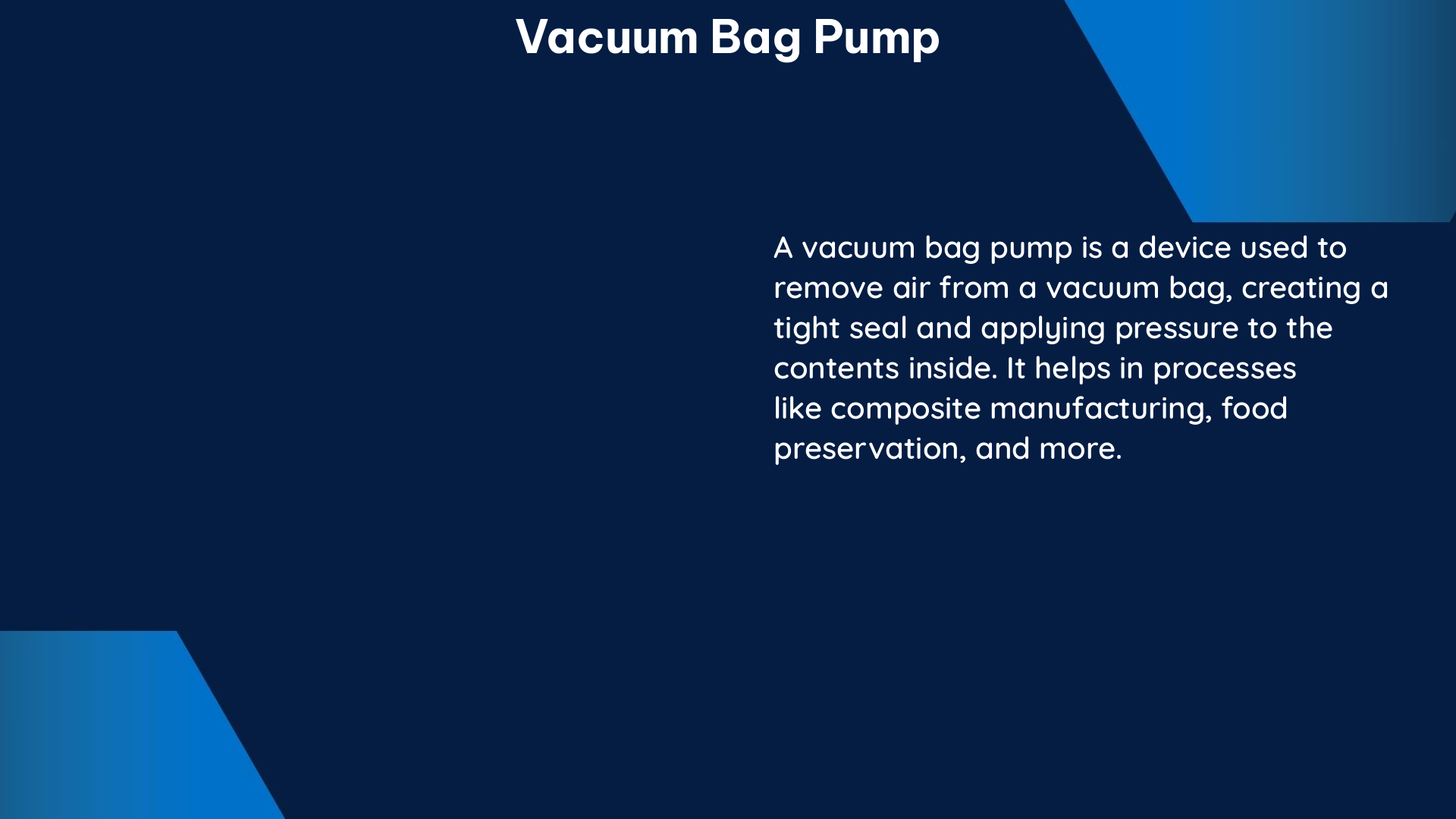Vacuum bag pumps are essential tools in the world of composite manufacturing, playing a crucial role in the vacuum bagging process. This process removes trapped air, compacts fiber layers, reduces humidity, and optimizes the fiber-to-resin ratio of composite laminations. The pump creates a pressure differential between the closed system within the bag and the open atmosphere, providing a uniform mechanical clamping force that ensures the desired properties of the final composite product.
Selecting the Right Vacuum Bag Pump
When selecting a vacuum bag pump, there are several key factors to consider:
Motor Horsepower
The horsepower of the motor is a crucial specification that determines the pump’s overall power and capacity. Higher horsepower motors can handle larger vacuum bags and achieve deeper vacuum levels more efficiently.
Pumping Mechanism
Vacuum bag pumps can utilize different pumping mechanisms, such as rotary vane, diaphragm, or piston-based designs. Each mechanism has its own advantages and trade-offs in terms of performance, noise level, and maintenance requirements.
Air Displacement (CFM)
The volume of air displaced by the pump, measured in cubic feet per minute (CFM), is a critical factor in determining the pump’s ability to evacuate air from the vacuum bag. Matching the CFM rating to the size of the vacuum bag is essential for achieving the desired vacuum level.
Maximum Vacuum Pressure
The maximum attainable vacuum pressure, measured in inches of mercury (“Hg), is another important specification. Selecting a pump with a higher maximum vacuum pressure can ensure that the desired level of vacuum is reached, even in larger or more complex vacuum bag setups.
It is crucial to match the bag size, desired vacuum rate, and ultimate pressure with the pump’s specifications for optimal performance. A smaller pump can often attain a desired vacuum level on a large system, but it will take much longer to achieve that level. Conversely, if a leak is present in a system that exceeds the CFM rating of the pump, even a partial vacuum will be difficult to achieve.
Vacuum Coupling and Tubing

The #891-A Vacuum Coupling is a critical component that creates a leak-free union between the vacuum bag and the tubing, ensuring the vacuum is maintained throughout the system. The pump must be connected to the bag by tubing, and the primary consideration in tubing selection is its ability to withstand the vacuum pressure without collapsing.
Vacuum Pumps in Sugar Processing
In the context of sugar processing, vacuum pumps play a vital role in removing incondensable gases that accumulate in vessels operating under vacuum, such as vacuum pans and final effect evaporators. The capacity of the vacuum pump to remove these incondensable gases is critical, and it needs to be sized to remove the total volumetric flow of incondensable gas and water vapor.
Measuring Incondensable Gas Flow
To measure the quantity of incondensable gas removed by a liquid vacuum pump, the estimated mass flow of incondensable gas needs to be converted into a volumetric flow at the operating conditions of the pan. The incondensable gas will be accompanied by water vapor since the gas will be fully saturated when it leaves the condenser. The vacuum pump has to be sized to remove the total volumetric flow of incondensable gas and water vapor.
Incondensable Gas Flow Rates
Incondensable gas flow is typically measured in kg/hr, and the design maximum, conventional design, and design minimum incondensable gas flow rates are critical factors in selecting the correct pump. Pump manufacturers normally supply graphs to determine the necessary correction factors, and conventional testing for load and capacity to remove incondensable gasses is essential to ensure the pan is capable of consistently achieving its design operating pressure.
Conclusion
Vacuum bag pumps are essential components in the world of composite manufacturing and sugar processing, playing a crucial role in the vacuum bagging process and the removal of incondensable gases. By understanding the key factors in selecting the right vacuum bag pump, such as motor horsepower, pumping mechanism, air displacement, and maximum vacuum pressure, as well as the importance of vacuum coupling and tubing, you can ensure optimal performance and achieve the desired results in your applications.
References:
– Explore Composites. (2020-05-31). Introduction to Vacuum Bagging – Explore Composites!. Retrieved from https://explorecomposites.com/articles/lamination/basics-vacuum-bagging/
– Measuring the quantity of incondensable gas removed by a liquid …. (n.d.). Retrieved from https://citeseerx.ist.psu.edu/document?doi=1bb370bb045182b8b77b14f1219f6905cb3e0bbb&repid=rep1&type=pdf
– Fibre Glast. (n.d.). Vacuum Bagging Equipment and Methods – Fibre Glast. Retrieved from https://www.fibreglast.com/product/vacuum-bagging-equipment-and-techniques-for-room-temp-applications

The lambdageeks.com Core SME Team is a group of experienced subject matter experts from diverse scientific and technical fields including Physics, Chemistry, Technology,Electronics & Electrical Engineering, Automotive, Mechanical Engineering. Our team collaborates to create high-quality, well-researched articles on a wide range of science and technology topics for the lambdageeks.com website.
All Our Senior SME are having more than 7 Years of experience in the respective fields . They are either Working Industry Professionals or assocaited With different Universities. Refer Our Authors Page to get to know About our Core SMEs.